Early successional vegetation can be found in various habitat types, including grasslands, prairies, old fields, woodlands and forests. White-tailed deer use these areas for bedding and escape cover. These habitat types also provide important food sources for deer and other wildlife (Figure 1).
With Missouri's temperate climate and rainfall, early successional habitats will not remain static but will change over time in a process called ecological succession. Ecological succession, or plant succession, is the orderly process of one plant community transitioning or "advancing" to another over time. Starting from bare ground, annual plants are the first to establish, followed by perennials, which eventually shade-out many of the annuals. As plant succession progresses, woody perennial plants, such as vines and shrubs, become established. Next, larger trees that are more shade tolerant will become established, and if not disturbed, the plant community will gradually advance to form a woodland and eventually a closed-canopy forest. Figure 2 depicts a typical sequence of change from one plant community to another.
Many wildlife species — including bobwhite quail, wild turkey and cottontail rabbits, as well as white-tailed deer — benefit from the food and cover provided by early successional vegetation, particularly when these types of habitats are interspersed with shrubby cover, woodlands and forested habitats across the landscape. To keep these early successional plant communities from advancing to later stages of succession, some sort of disturbance is required.
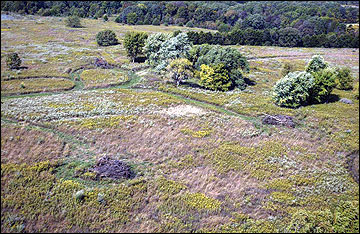 Figure 1
Figure 1
Early successional vegetation benefits many wildlife species in addition to white-tailed deer, especially when interspersed with shrubby cover, woodlands and forested habitats.
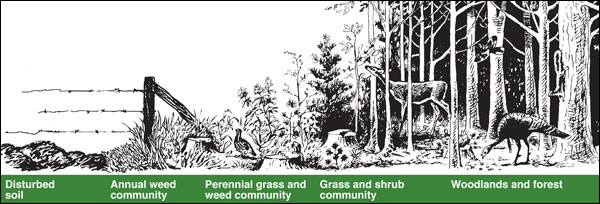
Figure 2
Plant communities transition from bare soil to mature hardwood forest. Early successional plant communities can be created and maintained through the use of a variety of management practices.
Ideal plant composition
Early successional habitats are characterized by a herbaceous cover that is in a mix of beneficial annual and perennial broad-leaved plants, called forbs; perennial grasses that are clumpy and have an open canopy; and a variety of shrubs that thrive after a disturbance (Figure 3). Disturbances create open, bare ground that allows maximum sunlight to reach the soil, stimulating the plants within the seed bank to germinate and dominate the site.
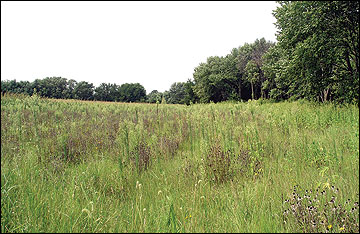 Figure 3
Figure 3
Early successional areas offer a diversity of plants types, including broad-leaved plants, which are important for deer forage.
Forbs
Disturbance at ground level promotes the germination of herbaceous broad-leaved plants, such as ragweed, partridge pea, beggar's lice, pokeweed, asters, native lespedezas and clovers. Broad-leaved plants, or forbs, are high in protein and typically comprise a significant percentage of a deer's diet, about 70 percent in the spring and summer.
Forbs not only provide valuable forage but they can also provide excellent cover that deer use throughout the year. Many native forbs grow as high as 3 to 6 feet, unless they are mowed down, and can provide areas of concealment for fawns and of bedding cover, especially during the winter months.
Grasses
Native warm-season grasses — specifically big and little bluestem, broomsedge, indiangrass, switchgrass and eastern gamagrass — are desirable in early successional habitats. These grasses are much preferred over nonnative cool-season grasses, such as tall fescue, because they provide the vegetative structure for improved fawning and winter cover (Figures 4 and 5). However, these grasses should not be allowed to get rank, as that would limit their diversity and early succession value.
Although deer eat very little grass of any kind during the summer, the growth characteristics of native warm-season grasses provide excellent winter cover and the structure that allows desirable forbs to grow within the field. Native warm-season grasses in fields are also essential for providing the fuel necessary to carry a prescribed fire, which is an extremely important practice for managing early successional communities.
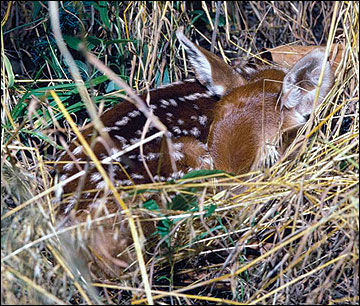 Figure 4
Figure 4
During the first weeks of life, fawns conceal themselves to avoid predators and often use early successional areas for cover.
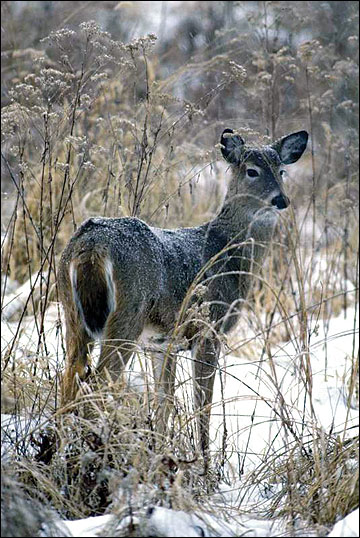 Figure 5
Figure 5
Native grasses that are 3 to 6 feet tall can provide ideal cover for deer in winter.
Shrubs and small trees
Scattered shrubs and small trees can make fields of native warm-season grasses and associated forbs more attractive to deer (Figure 6). Shrubs and small trees such as blackberry, sumac, sassafras, dogwoods, elderberry, wild plums, persimmon, hazelnut, witchhazel, hawthorn, American crabapple and wild cherry provide cover and important food for deer throughout the year (Figure 7). These shrubs can be important for wildlife, but they are often mowed before they can provide any benefits.
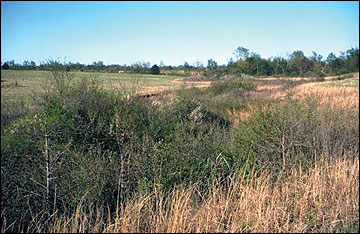 Figure 6
Figure 6
Shrubs in old field habitats provide deer with important browse plants as well as concealment cover.
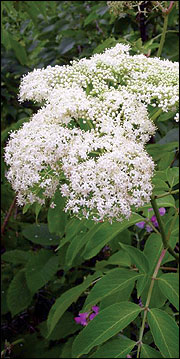

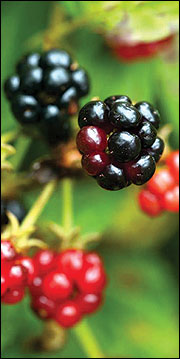 Figure 7
Figure 7
Elderberry, sumac and blackberry are a few of the shrubs that are commonly found in early successional habitats.
Establishment and management practices
Management of early successional habitats requires the implementation of practices that set back plant succession at various times to achieve the desired objectives. Management practices such as prescribed burning, disking and using herbicides can each be used, sometimes in combination, to set back plant succession. Although mowing or brush cutting (sometimes called Bush Hogging) can also be used to set back plant succession, it is not a recommended practice in most situations. Timber harvests and livestock grazing can also set back plant succession but are not covered in this publication. Depending on the site, some practices will provide greater benefits and be more economical to implement than others. Specific recommendations for managing these habitats will ultimately depend on the landowner's objectives.
Early successional habitats should also be managed so that a diversity of vegetation is available and interspersed across the property. The plant species composition and structure of early successional habitats can be balanced by conducting appropriate habitat management practices at the proper frequency and times of year.
Knowing which management practices can achieve the desired results — and their proper timing and application — is important when determining which practices to implement (Table 1).
Table 1. Timing of management practices to encourage growth of early successional vegetation.
| Spring | Summer | Fall | Winter | |
|---|---|---|---|---|
| Prescribed burn | X | X | X | |
| Herbicide application | X | |||
| Cedar removal | X | X | X | X |
| Strip disking
| X | X | ||
| Mowing | Mowing alone reduces wildlife habitat value and should be used only in combination with other management practices. | |||
Prescribed fire
In most situations, prescribed burning is by far the single best management practice for creating and maintaining early successional plant communities. The use of a prescribed burn (also called a prescribed fire or a controlled burn or fire) involves the controlled application of fire in a predetermined area to remove plant litter, stimulate the germination of seeds, control undesirable woody vegetation and set back plant succession (Figures 8a and 8b). Prescribed fire can be used in grasslands, old field habitats and woodlands, during either the dormant winter months or the growing season, to accomplish a specific management objective.
 Figure 8a
Figure 8a
The use of controlled fire is one of the best ways to maintain early successional areas.
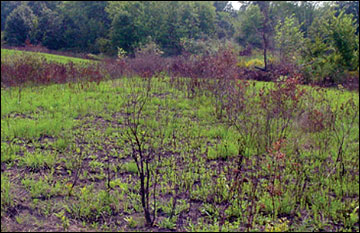 Figure 8b
Figure 8b
Vegetation quickly regrows after a burn.
Frequency and season
The timing of burns and the interval between burns, called the return interval, will greatly influence the plant community's response. For example, burning on a short return interval (one- to two-year rotation) will promote an early successional plant community that is dominated by grasses and forbs, whereas a longer interval (three- to five-year rotation) will give shrubs and woody plants a chance to develop.
The season in which a prescribed fire is conducted will affect the plant composition as well. Burning during the dormant season (January to March) tends to maintain the existing vegetation composition but, over time, will result in an increased density of grass on the area. Burning during the growing season will tend to reduce the density of grasses and increase the germination of forbs and legumes. In addition, burning during the growing season on a one- to two-year return interval will virtually eliminate woody cover from the area and favor a plant community dominated by herbaceous species. For example, if undesirable woody species — such as green ash, honey locust or red maple — begin to encroach into a field, burn the area in late summer or early fall. A burn at this time will kill the trees by preventing the flow of carbohydrates down to the root system for winter storage. Dormant and spring fire will often top-kill deciduous, woody sprouts but are not as effective in control as late-summer, early-fall burns.
To maintain a mixture of grasses, forbs and scattered shrubs, burning on a two- to four-year return interval is often recommended, depending on the specific site conditions. Increasing the burn return interval to three to five years will promote additional shrub cover and allow for additional soft mast production.
A recommended practice is to spread burning activities across a property or management area during any year, making sure that newly burned areas are left adjacent to areas that have not been burned for one, two or three years. This practice provides a diversity of early successional habitats and a variety of food sources and protective cover that deer will use (Figure 9).
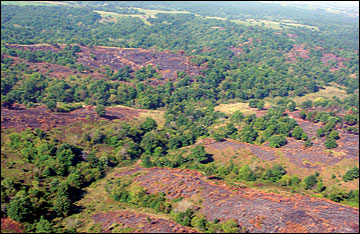 Figure 9
Figure 9
Applying fire in a mosaic pattern allows for a diversity of cover and food sources for a variety of wildlife including deer.
Develop a burn plan and establish firebreaks
Before conducting a prescribed fire on your property, seek professional advice in developing a burn plan to ensure that the burn will achieve the desired objectives.
Safety is a critical component of a burn plan. Before a burn, establish safe firebreaks around the field (Figure 10). Firebreaks can also be established to protect important shrubs — such as blackberry patches, plum thickets and stands of sumac — and can be strategic locations for establishing food plots beside the burned areas.
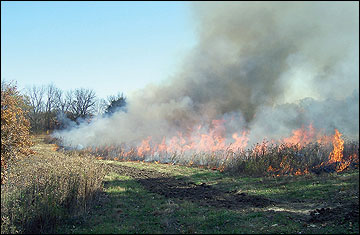 Figure 10
Figure 10
Establish fire lanes around areas to be burned. Fire lanes can be left fallow or planted to a food plot mixture of early successional plants.
Disking
Disking is another practice used to set back plant succession (Figure 11). Disking, particularly when conducted in a field composed of a dense stand of grasses, can stimulate the germination of a variety of native forbs that are favored by deer. Increased forb cover provides greater amounts of forage for deer. Disking promotes the growth of such highly desirable plants as ragweed, partridge pea, asters, ticktrefoil, native lespedezas and sunflowers.
 Figure 11
Figure 11
Disking promotes the growth of important forbs, legumes and annual grasses that deer use throughout the year.
Frequency and season
The timing and frequency of disking will influence the area's plant composition and will depend on the management objectives. To maintain annual plant communities, fields should be disked on a one- to three-year rotation.
A common recommendation is to develop a three-year disking rotation by dividing the field into adjacent areas that each contains three strips of land that are 30 to 50 feet wide. This division results in plots that are 90 to 150 feet wide (Figure 12). During the fall of the first year, disk one-third of the field in a strip pattern. In each of the next two years, disk a different third of the field so that 1-, 2- and 3-year-old plant communities are maintained within the field.
Disking can be done at various times of the year, from late fall to early spring. The seasonal timing will influence the vegetative structure and composition of the plant community. Disking during the fall often increases the growth of forbs and legumes within stands of grass, whereas early spring disking tends to promote the growth of annual grasses such as foxtails and millets. The optimal time to conduct strip disking in Missouri is from late October to early March. Delaying until early spring enables cover to stand through the winter and promotes the growth of favorable forbs.
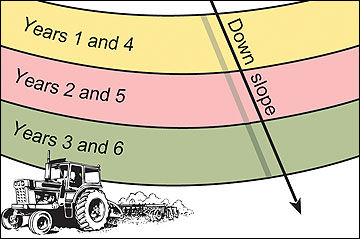 Figure 12
Figure 12
A three-year rotation of disking strips within a field provides multiple stages of early successional habitat in one area.
Selective use of herbicides
If undesirable cool-season grasses dominate the field, often the first step that needs to be taken is to remove these grasses by applying herbicides (Figure 13). In many cases, potentially good early successional habitat has been choked out by cool-season grasses such as tall fescue, orchard grass or smooth brome. Although these fields can be converted to better cover with well-timed prescribed fires, it can be a long, slow process. The selective use of herbicides can expedite the process by removing cool-season grasses to allow the growth of more beneficial native warm-season grasses and forbs. Once the field has been converted, prescribed fire and disking practices can be used to maintain this desired plant composition and habitat.
Different plants require different herbicides and application techniques to be effectively controlled, so be sure to check the label to ensure you have selected the appropriate herbicide and carefully follow all label directions for application.
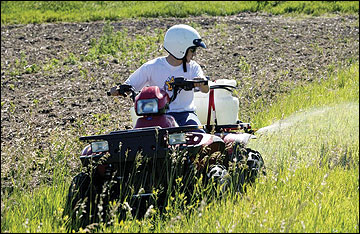 Figure 13
Figure 13
Herbicide applications and spot-spraying to control undesirable plants, such as tall fescue and sericia lespedeza, may be necessary to maintain the quality of early successional habitats.
Frequency and timing
For controlling perennial cool-season grasses, such as tall fescue, prepare the field for herbicide application by either conducting a prescribed fire or haying during August or early September. After either practice, the undesirable cool-season grasses will put on a new flush of growth. Allow the grasses to grow to about 6 inches tall, and then treat them with a glyphosate herbicide. Conducting this practice during the fall rather than the spring is recommended as fall applications improve control and do not typically harm desirable native warm-season grasses and forbs.
Another option is to conduct a prescribed fire in the early spring, followed by application of a grass-only herbicide, which reduces competition and allows the forbs to become established and thrive.
Mowing
As previously mentioned, mowing can set back plant succession, but mowing is the least desirable management practice for maintaining early successional vegetation and old field habitats (Figure 14). Frequent mowing tends to cause debris and thatch to accumulate at the ground layer, suppressing the germination of valuable native forbs and legumes that are in the seed bank. In addition, mowing during the growing season destroys fawning cover that deer require and nesting cover used by a variety of birds.
In situations where burning is either not an option or is an option only during a very brief time, and disking is also not an option, mowing becomes an alternative. One recommendation is to mow early successional vegetation and advanced stages of growth in old field habitats in late winter (January to early March), just before spring green-up. This timing allows deer to use the existing cover through most of the winter and preserves fawning cover and succulent new growth of plants provided by these habitats in spring and summer. Do not mow these areas during the spring or summer.
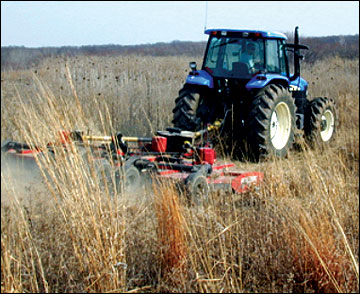 Figure 14
Figure 14
Mowing can prepare a field for early successional management, but it is rarely a good stand-alone habitat management practice.
Conclusion
In Missouri, the plant composition and structure provided by early successional vegetation is dynamic and rapidly changes from year to year depending on rainfall and the productivity and fertility of the soil. Over the course of just a few months or years, early successional plant communities can advance to later successional communities.
Establishing and maintaining early successional plant communities requires active management on a recurring basis. The effort and persistence of maintaining these plant communities result in enhanced habitat for white-tailed deer and other wildlife species on your property.
A Missouri Department of Conservation private land conservationist or your local MU Extension Center can provide more information and technical guidance about these practices and the most appropriate management practices for you to use based on your situation and objectives.
Additional information
- Lashley, M.A., C.A. Harper, G.E. Bates, and P.D. Keyser. 2011. "Forage availability for white-tailed deer following silvicultural treatments in hardwood forests." Journal of wildlife management 75(6):1467–1476.
- Kammermeyer, K., K.V. Miller, and L. Thomas Jr., eds. 2006. Quality food plots. Bogart, GA: Quality Deer Management Association.
- Pierce, R.A. II, T. Reinbott, R. Wright, B. White and L. Potter. 2012. Establishing and managing early successional habitats for wildlife on agricultural lands: A case study featuring habitat practices designed to benefit bobwhite quail conducted at the MU Bradford Research Center (MP907). Columbia: University of Missouri Extension.